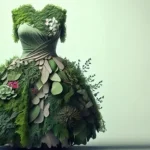
The fashion industry, notorious for its environmental impact, is undergoing a significant shift towards sustainability. At the forefront of this transformation are recycled and upcycled textiles, which are gaining immense popularity. This movement is driven by a growing consciousness about the environmental consequences of fast fashion and a desire to create products with a lower ecological footprint.
Understanding the Difference: Recycling vs. Upcycling
While often used interchangeably, recycling and upcycling are distinct processes. Recycling involves breaking down textile waste into its constituent fibers, which are then reprocessed into new yarn. Upcycling, on the other hand, involves transforming existing textiles into new products without breaking down the material.
- Recycling: This process is more complex and requires advanced technology. In India, there are increasing efforts to establish recycling facilities for textile waste. For instance, the government’s ‘Clean India’ mission has a focus on waste management, including textile waste. However, challenges such as the separation of different types of fibers, the removal of dyes and finishes, and the development of cost-effective recycling technologies still persist.
- Upcycling: This process is relatively simpler and can be implemented at a smaller scale. It has gained popularity among Indian designers and entrepreneurs. Many fashion labels are using discarded sarees, old denim, and other textile scraps to create unique and stylish garments. For example, several brands have successfully upcycled truck tarpaulins into trendy bags and accessories.
Benefits of Recycled and Upcycled Textiles
The adoption of recycled and upcycled textiles offers a multitude of benefits for both the environment and the economy.
Environmental Impact
By reducing the consumption of virgin materials, these practices help conserve natural resources, reduce water and energy usage, and minimize landfill waste. The textile industry is a major contributor to water pollution due to the dyeing process. Recycled and upcycled textiles can significantly reduce this impact.
Economic Opportunities
The circular economy model created by recycling and upcycling can generate new jobs and economic growth. In India, several self-help groups and small-scale enterprises are involved in upcycling activities, providing livelihood opportunities for marginalized communities.
Consumer Appeal
Consumers are becoming increasingly conscious of the environmental impact of their choices. Products made from recycled and upcycled materials appeal to this growing segment of environmentally conscious consumers.
Challenges and Opportunities
While the potential of recycled and upcycled textiles is immense, several challenges need to be addressed for widespread adoption.
Material Quality
A significant hurdle in the widespread use of recycled textiles is the quality of the resulting fibers. Compared to virgin fibers, recycled ones often exhibit inferior properties such as reduced strength, color inconsistency, and diminished softness. These factors directly impact the performance and durability of the final product, making it challenging to compete with conventional textiles in terms of quality and consumer satisfaction. To overcome this, substantial research and development efforts are required to refine recycling processes and develop innovative technologies capable of producing recycled fibers that meet the standards of virgin materials.
Supply Chain
Establishing a robust and reliable supply chain for textile waste is another critical challenge. The successful implementation of recycling and upcycling initiatives hinges on a consistent and sufficient supply of suitable materials. This necessitates the development of efficient collection systems, sorting facilities, and transportation networks to gather textile waste from various sources, including households, textile manufacturers, and retailers.
Furthermore, there is a need for clear regulations and incentives to encourage waste segregation and collection. Additionally, addressing the issue of contamination within textile waste, such as the presence of non-textile materials, is crucial for ensuring the quality of the recycled material.
Consumer Perception
Overcoming consumer skepticism and misconceptions about recycled and upcycled products is essential for market growth. Many consumers harbor preconceived notions about the quality, aesthetics, and performance of these products, often associating them with inferior alternatives. To shift this perception, comprehensive education and awareness campaigns are necessary to highlight the environmental benefits, ethical considerations, and style potential of recycled and upcycled fashion.
Building trust and credibility through transparent labeling, certifications, and storytelling can also help to dispel negative stereotypes. Ultimately, creating high-quality, desirable products made from recycled and upcycled materials is crucial to demonstrating the value proposition and driving consumer adoption.
Despite these challenges, the future of recycled and upcycled textiles is promising. With increasing consumer demand, technological advancements, and government support, the textile industry can successfully transition towards a more sustainable and circular model.
Tips for Efficient Use of Recycled and Upcycled Textiles
- Collaborate with Designers: Partner with designers who specialize in sustainable fashion to create innovative and appealing products.
- Explore Different Materials: Experiment with various recycled and upcycled materials to find the best fit for your products.
- Build Strong Supply Chains: Establish reliable partnerships with suppliers of recycled and upcycled materials.
- Educate Consumers: Create awareness about the benefits of using recycled and upcycled products.
- Embrace Technology: Utilize technology to improve the efficiency of recycling and upcycling processes.
By adopting these strategies, businesses can effectively leverage the potential of recycled and upcycled textiles while contributing to a more sustainable future.





Leave a Reply